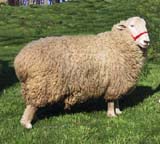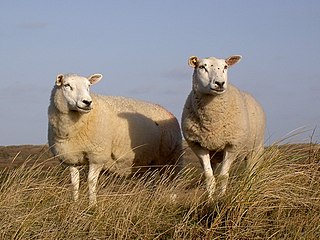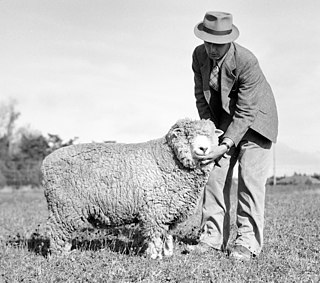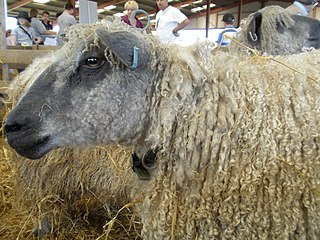Related Research Articles

The Blackface or Scottish Blackface is a British breed of sheep. It is the most common sheep breed of the United Kingdom. Despite the name, it did not originate in Scotland, but south of the border.

The Coopworth is a modern New Zealand breed of sheep. It was developed by researchers at Lincoln College in the Canterbury region of the South Island between about 1956 and 1968, the result of cross-breeding of New Zealand Romney ewes and Border Leicester rams. It has become the second-most numerous sheep breed in New Zealand, and has been exported to Australia, some European countries, and the United States.

The Drysdale is a New Zealand breed of sheep. It was developed from 1931 by Francis Dry, and derives from sheep of the New Zealand Romney breed in which a mutation caused the coat to be particularly hairy, and thus suitable for carpet-making. It is a specialised carpet wool breed, but also a useful meat breed.

The Cotswold is a British breed of domestic sheep. It originates in, and is named for, the Cotswold hills of the southern midlands of England. It is a large long-woollen sheep, and is kept as a dual-purpose breed, providing both meat and wool.

The Suffolk is a British breed of domestic sheep. It originated in the late eighteenth century in the area of Bury St. Edmunds in Suffolk, as a result of cross-breeding when Norfolk Horn ewes were put to improved Southdown rams. It is a polled, black-faced breed, and is raised primarily for its meat. It has been exported to many countries, and is among the most numerous breeds of sheep worldwide.

The Oxford Down is a British breed of domestic sheep. It was developed in the 1830s by cross-breeding of Hampshire Down and Southdown ewes with Cotswold rams. It is reared primarily for meat.

The Southdown is a British breed of domestic sheep, the smallest of the British breeds. It is a shortwool breed, and the basis of the whole Down group of breeds. It was originally bred by John Ellman of Glynde, near Lewes in East Sussex, in about 1800. It has been exported to many countries; it has been of particular importance in New Zealand, where it was used in the breeding of Canterbury lamb. In the twenty-first century it is kept principally as a terminal sire.

The Texel is a Dutch breed of domestic sheep originally from the island of Texel. It is a heavy and muscular sheep, and produces a lean meat carcass. It is polled, clean-faced and clean-legged, with white face and wool. The fibre diameter of the wool averages about 32 μ, with a staple length of 8–15 cm; it is used mainly for knitting and hosiery wools.

The Corriedale is a New Zealand breed of sheep. It was bred from about 1882 in the South Island by James Little, who cross-bred Merino and Lincoln Longwool sheep. The breed was officially recognised in 1911. It has been exported to Australia and to many countries in Africa, Asia, Europe and North and South America. In 2021 it was reported from twenty-five countries, and the total population was estimated at just over 5 million.
The Easycare or Easy Care is a modern British breed of easy-care sheep. It was developed in Wales in the second half of the twentieth century by cross-breeding between Welsh Mountain and Wiltshire Horn stock, with the aim of combining the meat-producing qualities and natural moulting characteristic of the latter with the hardiness of the former. It is reared for meat production.

The Dorset Horn is an endangered British breed of domestic sheep. It is documented from the seventeenth century, and is highly prolific, sometimes producing two lambing seasons per year. Among British sheep, it is the only breed capable of breeding throughout the winter.

The Clun Forest is a breed of domestic sheep originating from the area surrounding the Clun Forest in Shropshire, England. Similar to many of the British breeds of upland sheep, Clun Forest are hardy, adaptable, good foragers, and are long–lived. With sleek heads and wide pelvic structures, Clun Forest ewes lamb easily. The breed has a short to medium–length wool and dark brown faces. They are a multi–purpose animal, kept for meat, wool, and milk. Like other dark faced sheep, Clun produce quality lamb and mutton. However, in contrast to more common meat breeds such as Suffolks, their wool is free of undesirable black fibres and kemp, and is suitable for handspinning. The breed's alert and stylish appearance, together with its reputation for hardiness and fecundity have made it popular with hobby farmers and large commercial flock owners alike. The Official Clun Sheep Breeders Society Show & Sale for males and females is held annually in early September at Ludlow livestock market by McCartneys.

The Wensleydale is a British breed of domestic sheep. It is named for the Wensleydale region of North Yorkshire, in the north of England, where it was bred in the early nineteenth century by cross-breeding a Dishley Leicester ram with local long-woolled sheep of a breed that is now extinct. It has a blue-grey face and long purled wool, and is among the heaviest of British sheep breeds. It is an endangered breed, and is categorised as "at risk" by the Rare Breeds Survival Trust. It is often used as a ram breed to cross with other breeds to obtain market lambs, and for its high-quality wool.
The Devon Closewool is a British breed of domestic sheep. It is distributed almost exclusively on Exmoor in North Devon, in south-west England. It is raised primarily for meat.
The Gentile di Puglia is a breed of domestic sheep indigenous to southern Italy. It originates from the Tavoliere di Foggia, a large plain in the northern part of Puglia, and is raised mainly in that region; a few are found in neighbouring regions. The Gentile di Puglia is sometimes known as the Merinos d'Italia, or Italian merino.
The Devon and Cornwall Longwool is a British breed of domestic sheep from South West England. It was created in 1977 through merger of two local breeds, the Devon Longwool and the South Devon.
Edilbay sheep, also known as Edilbaev(skaya) sheep, are a breed of domesticated sheep which originated in northern Kazakhstan. This breed belongs to the coarse-wooled fat-tailed type of sheep and the Kazakh group. It originated in the 19th century as a cross between Kazakh fat-tailed sheep and Kalmyk/Astrakhan coarse-wooled sheep. Today, it is found in Kazakhstan and Russia.

The New Zealand Romney is a New Zealand breed of sheep. It derives from British Romney Marsh stock imported to New Zealand in the nineteenth century, and was established as a separate breed in 1904. It is the most numerous sheep breed in New Zealand.

The Australian Merino is an Australian breed or group of breeds of sheep, forming a significant part of the Merino group of breeds. Its origins lie in Merino sheep imported to Australia from South Africa in about 1796. By about 1830 there were almost two million Merinos in the country.

The Cambridge is a modern British breed of domestic sheep. It was bred at the University of Cambridge by John Owen and Alun Davies between about 1964 and 1979, with the aim of increasing prolificacy. It is among the most prolific of all sheep breeds, but is critically endangered.
References
- 1 2 Barbara Rischkowsky, Dafydd Pilling (editors) (2007). List of breeds documented in the Global Databank for Animal Genetic Resources, annex to The State of the World's Animal Genetic Resources for Food and Agriculture. Rome: Commission on Genetic Resources for Food and Agriculture, Food and Agriculture Organization of the United Nations. ISBN 9789251057629. Archived 23 June 2020.
- 1 2 3 Breed data sheet: White Suffolk / Australia (Sheep). Domestic Animal Diversity Information System of the Food and Agriculture Organization of the United Nations. Accessed March 2024.
- 1 2 White Suffolk sheep. Farm Diversification Information Service, Department of Primary Industries, State of Victoria. Archived 6 September 2006.
- 1 2 Valerie Porter, Lawrence Alderson, Stephen J.G. Hall, D. Phillip Sponenberg (2016). Mason's World Encyclopedia of Livestock Breeds and Breeding (sixth edition). Wallingford: CABI. ISBN 9781780647944.
- ↑ David Cottle (2010). International Sheep and Wool Handbook. Nottigham: Nottingham University Press. ISBN 9781904761860.